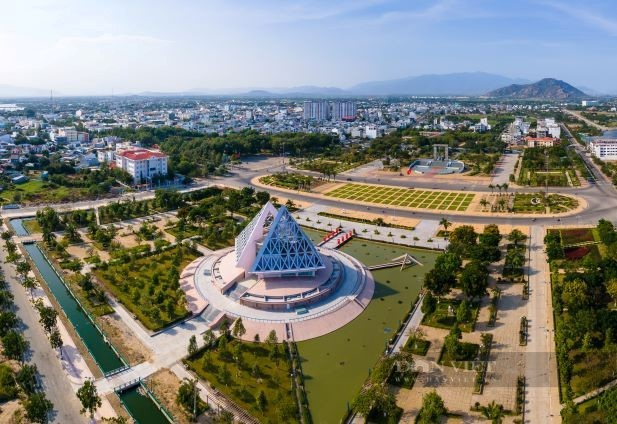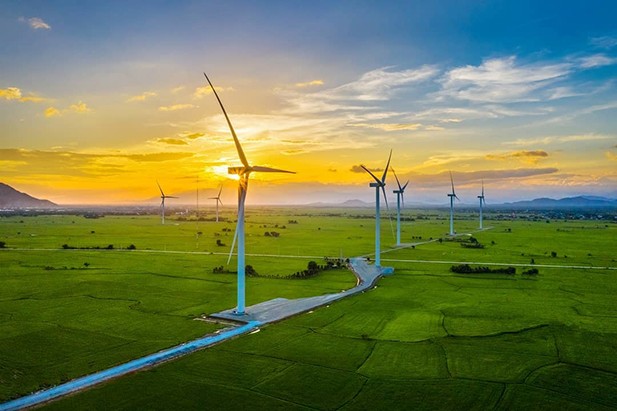(VOVWORLD) - April 1, 1992 was an important historical milestone for Ninh Thuan province. It marked the re-establishment of the locality encompassing the town of Phan Rang-Thap Cham, and the districts of Ninh Son, Ninh Hai, and Ninh Phuoc. In the 30 years since, Ninh Thuan has seen spectacular developments, and has achieved one of the most impressive economic growth rates in Vietnam.
 The complex of square - monument – museum in Ninh Thuan province. (Photo: Tran Duy/danviet.vn) The complex of square - monument – museum in Ninh Thuan province. (Photo: Tran Duy/danviet.vn)
|
When Ninh Thuan was re-established in 1992, its transportation system was poor. Only low-quality local roads passed through the central area of the province. Remote communes and ethnic minority areas were isolated with transportation involving mainly rudimentary means. As a result, trade was limited and life was difficult.
30 years later, regions have been linked by a carefully planned network of national highways, trans-provincial roads, trans-district roads, and local roads connecting communes.
This has made trade easier between Ninh Thuan and neighboring provinces, improved local living conditions, and helped Ninh Thuan achieve its socio-economic development goals.
During the 2011-2020 period Ninh Thuan developed comprehensively and sustainably. During the past 3 years, despite the COVID-19 pandemic, its GDP growth was one of the strongest in Vietnam.
Truong Van Tien, Deputy Director of the provincial Department of Planning and Investment, said that Ninh Thuan has implemented multiple solutions to improve the provincial competitiveness index and socio-economic development and has completed land planning for the 2021-2030 period.
“This will be the basis for future projects and attracting investors. Ninh Thuan will invest more in technical infrastructure, particularly for maritime transport and industrial clusters. Greater attention will be given to digital transformation in reforming administrative procedures, ensuring publicity and transparency, and facilitating investment,” said Tien.
 Dam Nai wind power field. (Photo: Thuc Trinh/ VNExpress) Dam Nai wind power field. (Photo: Thuc Trinh/ VNExpress)
|
In Ninh Thuan today wind and solar power fields have replaced empty, arid hillsides. In 2020 and 2021 the province attracted 49 renewable energy projects with a capacity of more than 3,000 MW. 43 of those projects are already in operation.
According to Dao Van Rot, Deputy Director of the provincial Department of Industry and Trade, to become a renewable energy hub of Vietnam, Ninh Thuan is trying to build a capacity of 6,500 MW by 2025 and 11,800 MW by 2030.
“To achieve those targets, we will focus on investing in infrastructure and mobilizing multiple sectors to develop transmission infrastructure,” Rot said.
With a coastline of more than 100 kilometers, Ninh Thuan is a popular tourist destination, famous for world-class luxury resorts, the unique Cham ethnic culture, and attractions such as Nui Chua National Park, recognized by UNESCO as a world biosphere reserve, and Vinh Hy Bay, one of the eight most beautiful bays in Vietnam.
Tran Quoc Nam, Chairman of the provincial People's Committee, said Ninh Thuan has been fully tapping all these advantages to become a top travel destination.
“We have promulgated many mechanisms and policies to attract investors in high-class tourism projects like the Amanoi resort, which has been rated one of the world’s top 10 resorts. We intend to continue adopting specific policies on renewable energy, tourism, high-tech agriculture, and new urban areas such as tourist cities and resort cities,” said Nam.
Under its development plan until 2030 with a vision to 2050, Ninh Thuan will become one of Vietnam’s most developed localities and a center of renewable, clean energy by 2025.
It plans to have a high per capita income by 2030, and by 2050 have a diverse and prosperous economy with a high development level compared to other localities in Vietnam and a green, healthy living environment.